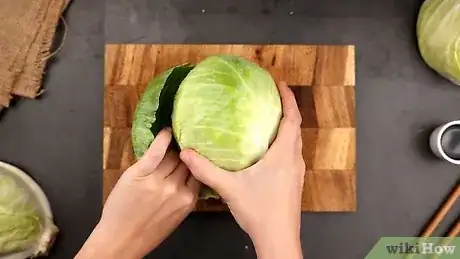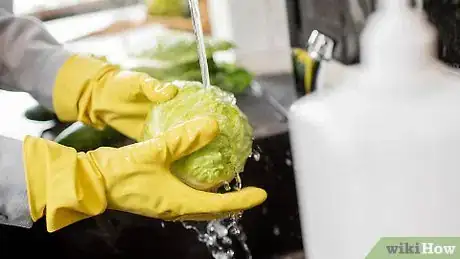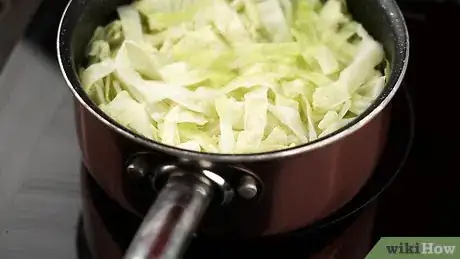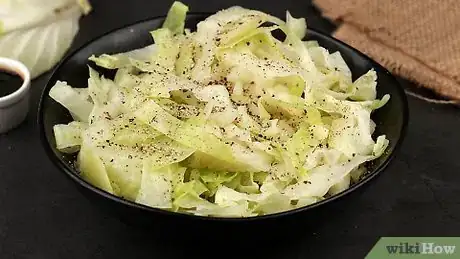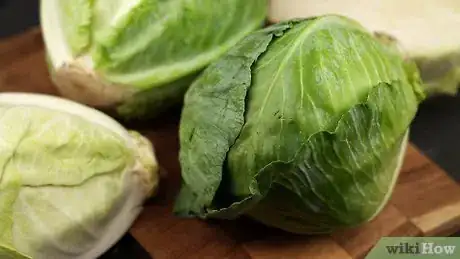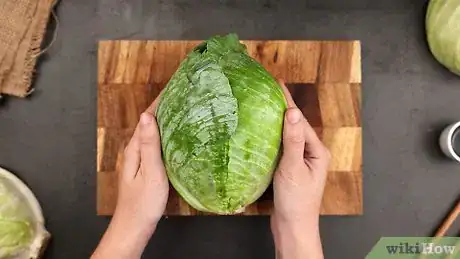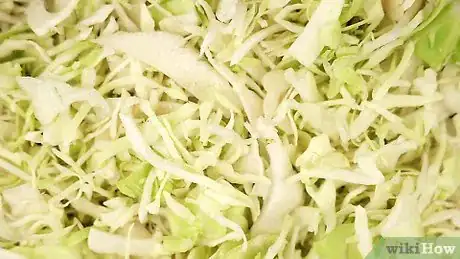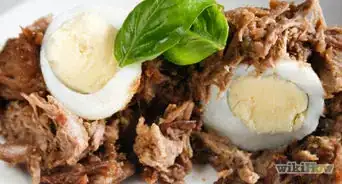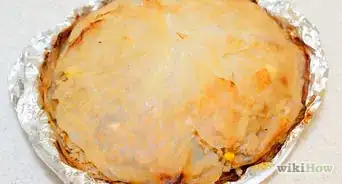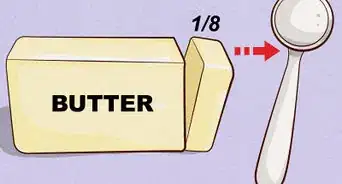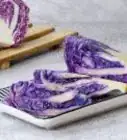This article was co-authored by wikiHow Staff. Our trained team of editors and researchers validate articles for accuracy and comprehensiveness. wikiHow's Content Management Team carefully monitors the work from our editorial staff to ensure that each article is backed by trusted research and meets our high quality standards.
The wikiHow Culinary Team also followed the article's instructions and verified that they work.
This article has been viewed 618,263 times.
Learn more...
Whatever variety of cabbage you prefer, you can be sure it contains a lot of vitamins and nutrients, particularly fiber. Cabbage is a healthy, leafy vegetable that can be eaten on its own or combined with other foods. There are many ways to prepare cabbage, and a popular cooking method is to boil it. Boil cabbage by cleaning and preparing it, then cooking it in hot water for just a few minutes.
Steps
Preparing the Cabbage
-
1Peel off the outer leaves from the cabbage head. Discard any leaves that look wilted, worn or discoloured. It's common practice to discard the outer leaves since it is the most exposed to dirt and damage.
-
2Rinse the entire head of cabbage. Rise it under a stream of cool water. It's extremely important that you rinse the cabbage thoroughly as most farms use pesticides and other insecticides to keep pests and diseases away from their crops.
- Organic cabbages should not have been grown with any pesticides or insecticides added but it's still important to rinse and clean your cabbage to rid it of any dirt, insects, eggs, or sand that may still be on your cabbage.
- You can also consider soaking your cabbage in saline water or plain water for 30 minutes to better clean it.[1]
Advertisement -
3Cut your cabbage. It is common to slice cabbage into wedges or into long, slim shreds but you can boil your cabbage in any form or shape you prefer.
- Be sure to cut out the stem or centre of the cabbage.
- Chop off any coarse stems that are at the bottom of the wedges you have cut.
-
4Shred or chop your cabbage into the desired shape. It is common to slice the cabbage wedges into long, slim shreds but you can boil your cabbage in any form or shape you prefer. You can also boil your cabbage in wedges.
- Shred the cabbage on a cutting board by placing it flat side down. Slice as thick or as thin as you want the shreds to be.
- Use a mandolin if you have one. This kitchen utensil will allow you to shred the cabbage by sliding it across a sharp blade
Boiling the Cabbage
-
1Bring water to a gentle boil over medium-high heat. The water should be about 3/4 of an inch (1.9 cm) deep or enough to place your cabbage in without overflowing.
- Don't worry about having the exact volume of water as you'll be draining any excess water out.
- Instead of water, you can use vegetable or meat stock to infuse flavour to your cabbage. Use liquid stock or mix powdered stock into your boiling water.
- A small amount of vinegar, about 10 ml, added to the water can prevent the strong odor that many people find objectionable.
-
2Add the cabbage to the boiling water. Don't worry about overcrowding your pot. The cabbage will absorb the water and decrease dramatically in volume.
-
3Cook uncovered at a simmer or gentle boil. Shredded cabbage can cook for about 5 minutes and wedges will take 10 to 15 minutes to cook.
- Keep an eye on the cabbage to ensure it does not overcook. Finished cabbage should become tender. Overcooked cabbage can release unpleasant flavours and aromas.
-
4Remove the cabbage from the pot. Use a slotted spoon, or pour it into a colander to get rid of the excess water.
- If you've used stock to boil your cabbage, the water may be used again for soups or even to drink at its present stage.
-
5Season the cabbage. Since cabbage can be quite bitter, use salt to balance out its taste but don't add so much that the cabbage tastes salty.
Selecting Cabbage
-
1Choose the type of cabbage that you'd like to eat. Green cabbage is the most popular type of cabbage, but you can also boil red cabbage, savoy cabbage, Napa cabbage or the Chinese cabbage, bok choy.
- Green cabbage: The classic green cabbage has wide fan-like leaves that have a waxy rubber feel when raw. It has a sweet taste when cooked but can taste quite peppery when eaten raw. White cabbage is a type of green cabbage which is a bit mushier when cooked, so extra care needs to be taken of this variety during cooking, to keep it firm and flavorful.
- Red cabbage: It's known for its dark reddish-purple leaves and have a deeper flavour than green cabbage. It's often used for pickling and adding colour to dishes.
- Savoy cabbage: This cabbage has a softer and crinkly feel to it with deep greens and white veins. It's high in vitamin K, vitamin C, and fiber and has a mild earthy taste to it.
- Napa cabbage: This cabbage comes in an oblong shape and looks closely like romaine lettuce with its yellow greenish leaves and prominent white stems. It tastes much sweeter when raw than green cabbages.[2]
- Bok choy: A traditional Chinese cabbage, bok choy is light and peppery or bitter to taste. When cooked, the white stems remain crisp while its leaves become soft. It is also quite watery compared to most cabbages.[3]
-
2Buy a head of cabbage that is firm and compact. You want leaves that are fresh and crisp, not wilted, brown or marked. The weight of the cabbage should also feel heavy for its size.
- Wilted or damaged outer leaves usually indicate the cabbage is old or has been handled rather roughly.
- The best time to harvest the freshest cabbage is during the summer. Cabbage tastes sweeter and better after frost as cabbage is usually grown in wet and cool conditions.
-
3Try not to buy shredded or pre-cut cabbage. While this may seem convenient, cabbage begins to lose its vitamin C and other nutrients as soon as it is cut.
- Shredded or pre-cut cabbage may also be stored for long periods of time, depleting its taste.
Community Q&A
-
QuestionDoes cabbage have vitamin K?
 Community AnswerCabbage, like other dark, leafy vegetables, contains high amounts of vitamin K, about 42 micrograms per cup of cabbage. Cooked cabbage not only does not decrease the vitamin K content, it actually triples the amount of vitamin K in the cabbage, about 162 micrograms per cup.
Community AnswerCabbage, like other dark, leafy vegetables, contains high amounts of vitamin K, about 42 micrograms per cup of cabbage. Cooked cabbage not only does not decrease the vitamin K content, it actually triples the amount of vitamin K in the cabbage, about 162 micrograms per cup. -
QuestionWhat spices or flavors do I put in cabbage?
 Community AnswerI use butter, garlic powder, salt, and pepper, but you can also use celery or mustard seed, tarragon, thyme, or nutmeg.
Community AnswerI use butter, garlic powder, salt, and pepper, but you can also use celery or mustard seed, tarragon, thyme, or nutmeg. -
QuestionCan I cook wedges of cabbage in the same pot as I cook the corn beef?
 Community AnswerYes. Cook the corn beef first, then add cabbage, mix in and let sit on low heat. The heat will cook it quickly.
Community AnswerYes. Cook the corn beef first, then add cabbage, mix in and let sit on low heat. The heat will cook it quickly.
Things You'll Need
- Cabbage
- Knife
- Cutting board
- Pot
- Slotted spoon
- Colander
References
About This Article
To boil cabbage, start by removing any outer leaves that appear wilted or discolored. Next, rinse the head of cabbage under cool water to wash away any dirt and pesticide residue. To help your cabbage boil faster and more evenly, chop it into wedges or shreds with a sharp kitchen knife. As you’re trimming the cabbage, cut out the hard stem and inner core, which are tougher and harder to eat than the leaves. Pour enough water into a pan so that it will submerge the cabbage when you add it without overflowing. For a more flavorful result, you can use vegetable or meat stock instead of water. You can also add 2 teaspoons (10 mL) of vinegar to the water to add flavor and neutralize the strong smell of the cabbage. Bring the water or stock to a gentle boil over medium-high heat, then add the cabbage. Simmer the cabbage for 10-15 minutes, or until it’s as tender as you like it. If you cut the cabbage into shreds, you may only need to cook it for 5 minutes. Remove the cabbage with a slotted spoon or strain it through a colander to get all the water out. Season your boiled cabbage to taste and enjoy! For more tips, including how to choose the best cabbage, read on!
